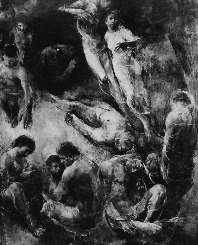Articles/Essays – Volume 02, No. 1
Art and Belief: A Critique
The recent exhibit of paintings by Mormon artists held at the Salt Lake City Public Library was not, as many people hoped or expected, a confirmation of what might be called a Mormon style. The painters, if I understand their intentions correctly, were interested in expressing individual belief rather than religious consensus. The brochure describing the exhibit states that the work reflects “personal approaches to the expression of their [the artists’] beliefs.” But because the artists were painting within the same framework of convictions one would, nevertheless, expect a consensus of sorts. There needen’t be prior agreement for artists to produce a religiously or philosophically similar art. If they have common grounds for belief, certain similarities are unavoidable, as long as each individual responds honestly to his own belief and experience. If art is created as an act of religious devotion, the devotion grows out of parallel, not divergent, concepts of God.
I do not think that the sincerity of devotion in these paintings is in question. Nor is the quality of the art itself, at least for my purposes. Many of the paintings were undeniably good. What I did find central to this exhibit is the question: Do these paintings represent the emergence of a Mormon tradition in art?
Unless this question can be answered in the affirmative, the show was no more, no less, than a collection of paintings by artists who are incidentally members of the Church of Jesus Christ of Latter-day Saints. Furthermore, if this is the case, the exhibit should not have called attention to the religious affiliation of the artists. It is one thing to identify artists with a locale or a school, quite something else to identify them with a religion which would specifically shape the style and content of art.
However, the shaping force of Mormonism seemed to be absent from these paintings in general. But then the exhibit was small, the range of styles and subjects rather wide: abstracts by Larry Prestwich, poem-paintings by Dennis Smith, pastorals by Mike Coleman, depictions of youth by Dale Fletcher, and embryonic forms and almost mystical interpretations by Gary Smith. But I found in these paintings no commanding or decisive religious impulse that could be called Mormon, with the exceptions, perhaps, of Trevor Sou they ‘s “Laying on of Hands” and “The Plan,” and Dennis Smith’s “Younger Brother.”
But subject alone is not enough to define art; neither is style. When the two are joined in an unmistakable resonance of belief, without self-consciousness or sentimentality, the art is sacramentally valid for the Church. Some argue that it is wrong to assume that there can be or should be a Mormon art, but I believe that such an art is inevitable once a visual tradition is established. As yet there is no visual tradition in the Mormon Church, and until there is the expressions of faith in art will be uncertain and tentative. Individuality will have little relevance to the common faith that gives shape, direction, and meaning to experience.
Therefore, if the exhibit lacked the clear, strong evidence of Mormon faith in particular, as opposed to faith in general, the fault lies not so much with the artists as with the lack of a visual tradition from which inspiration is drawn, a tradition which could likely emerge from the continued efforts of the Prestwichs, Southeys, Smiths, Fletchers, and Colemans, but which can only grow when the members of the Church collaborate in an active and vital way with the artists. A tradition is not for the few, but for the many. That is why I think the exhibit, despite certain disappointments, was important, and why I would like to see it become an annual event.


 Back to full Issue
Back to full Issue

